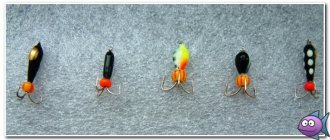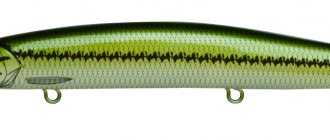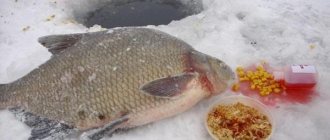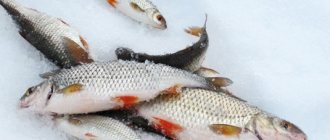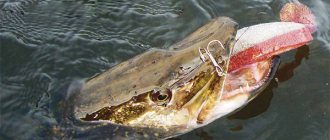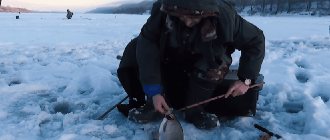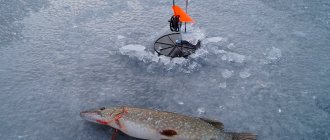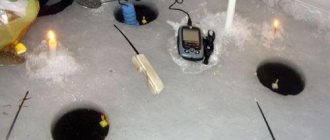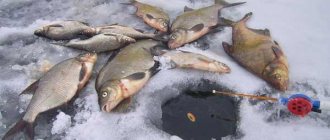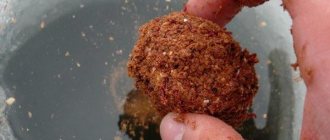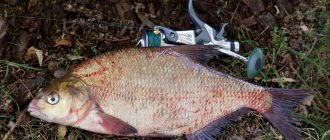Classification by weight
It is also customary to classify jigs by weight into:
- super heavy;
- heavy;
- average;
- lungs
The best jigs for fishing in deep water and fast currents are super heavy and heavy. Due to the fact that most of them are made of tungsten, which is almost 2 times heavier than lead, they are small in size and have a large weight (from 1 to 10 g).
The bait sinks quickly and has minimal resistance to flow. A lead analogue of the same weight will be 2 times larger, which in some cases, for example, in strong currents, makes it inapplicable.
Medium jigs are most often made of tin and lead. These are the most popular baits for winter fishing.
In addition, you can easily make them yourself by soldering a suitable hook into a piece of tin of the required size and weight. Simple homemade jigs are an ideal bait for winter crucian carp and perch, both with and without bait.
They are mainly used for fishing at medium depths.
Light jigs are used for fishing in shallow areas in bodies of water without a current. They are made from plates of copper, brass, silver, epoxy resin, plastic, nylon and painted in the required color.
Winter fishing for bream and bream
During winter fishing, many fishermen prefer to catch peaceful fish rather than bet on predators. In this article we will explain in detail all the points and nuances associated with winter ice fishing for bream and bream. Although such fishing is similar to ordinary winter fishing, there are several important points that should not be forgotten.
The first and one of the most important rules for winter bream fishing is strict adherence to silence in the selected area. Any sounds made by the fisherman can frighten the approaching bream, and the bite will stop for a long time. To avoid this, follow a few rules.
Firstly, when ice freezes on a slotted spoon or scoop, which is used to remove ice from a hole, the noise of the ice being knocked down alarms and scares away both large and small bream. Therefore, ice should be selected using plastic devices, or, in extreme cases, by hand.
Secondly, when moving from one hole to another (in search of active bream), do it quietly and carefully. There is no need to throw a fishing box or other heavy objects onto the ice, as short sharp sounds will be made, which, having passed through the thickness of the ice, will scare off the cautious bream.
And thirdly, before catching bream, it is advisable to drill the required number of holes in advance in the intended fishing location. First, make a couple of holes in the center of the area, and then drill them in a circle. If a school of fish moves away from the hole you are currently fishing in, you can quickly move to others located near the hole and “feel” for the school again without drilling any additional holes and thereby not scaring away the fish.
Fishing with a float
The most sensitive gear for winter fishing for bream and bream is considered to be float gear, although at this time of year not all fishermen prefer this method of fishing. With proper balancing of the tackle, the fish will not feel the jig, and most bites will be successful. When fishing for bream in winter, many anglers equip their float tackle with a regular hook and sliding sinker. This tackle has proven to be excellent when catching large specimens.
In order to properly balance the float tackle, experienced fishermen use two floats: a large elongated one and a small one that serves as a signaling device. These floats should balance the jig so that it barely submerges in the water in the test vessel. When fishing for bream on ice, the floats are usually moved apart by 50-60 cm.
Fishing with a jig with a nod
This fishing method is considered the most popular among fishermen. It involves the use of any jigs made from any material, any shape and color. The main thing is to choose the right size and weight of the jig. As a rule, it should be small so as not to frighten the vigilant bream. The most popular jig in winter fishing is considered to be the “pellet”.
A sensitive flexible spring 7-15 cm long is usually used as a nod, which perfectly reflects the bite of even small breams.
When winter fishing for bream with a jig, the wiring must be done in a certain sequence. First, tap the jig on the bottom for 15-20 seconds. Then it is smoothly raised up 1-2 cm, stopping there for 5-10 seconds. Continue this wiring 10-12 times. Then you can place the winter fishing rod so that the jig hangs over the bottom, and wait 5-10 minutes. If you still don’t notice a bite, you should move to a new hole and do the wiring according to the specified method.
Nozzles
For ice fishing for peaceful fish, bloodworms are traditionally used as bait. The only note is that it must be alive, fresh and active. Even if the bloodworm was purchased immediately before fishing, in frosts of 10 degrees or more, the bait laid out from the bloodworm will instantly freeze and will no longer be so active. As a result, the overall probability of catching bream will decrease. In order to keep the bloodworm active, it needs to be stored in a small bloodworm bottle that can easily fit in a jacket pocket. And your bait will always remain fresh, alive and active.
Sometimes maggots are also used for winter fishing for bream. If in summer or spring bream is not very active in taking maggots, then in winter its interest in such bait increases noticeably. Therefore, many fishermen use maggots as bait for ice fishing for bream and bream.
Groundbaits
Is it worth feeding bream during winter fishing? Fishermen are still debating this issue, without having come to a definite answer. However, most fishermen are inclined to believe that bream and bream still need to be fed in winter.
Bait can be of both plant and animal origin. Here they demonstrated themselves well: chopped worms, maggots, small bloodworms, as well as jigs. It is recommended to use ready-made feeding briquettes, which you can either buy or make yourself.
To make such briquettes ourselves, we will need plastic molds, for example, for children’s toys, mayonnaise, etc. Fill them with sand and preferably fine gravel, add bloodworms, and lightly water them. Then we put them in the freezer, and that’s it, our bait is ready. To quickly remove bait frozen to a plastic mold, pour boiling water over it, and the briquette will fall out of the mold itself. The finished bait needs to be wrapped in a bag, and you can safely go winter fishing.
To feed the fish, it will be enough to simply throw the briquette into the hole. Such bait will not float, since it contains heavy gravel and sand, and will quickly sink to the bottom. Lying on the bottom directly under the hole, the briquette will begin to slowly melt. Schools of fish will begin to approach the bait, tear off pieces from it, but they will not be able to break it into small parts. Therefore, such bait will act for a longer time.
As for plant baits, they are so diverse that they cannot be described in one article. Basic rules that apply to any plant fertilizer: it must be small; it must be prepared directly at the fishing site. There are a lot of recipes for making bait for winter fishing for bream and white bream. Each angler independently develops the most optimal composition of bait of plant origin.
We also note that when fishing for bream and bream in winter, they need to be fed as early as possible so that the bait begins to act faster and attract fish.
Some useful tips
If, after baiting the fish, you notice bream biting from medium depths, feel free to try fishing with a jig with a nod. Also use a nozzle such as a “devil”. With a smooth and slow retrieve, it guarantees a successful bite.
If the fish is not actively biting, try to "play" it. With frequent, gentle swings, work with a nod, while the jig should not rise much from the bottom.
Try working on a “deuce”: drill two identical holes, in one you fish with a jig, in the other with a float tackle with a hook and sinker. When actively working with a jig, all bites occur, oddly enough, on the float tackle.
If in the future you plan to fish in the chosen reservoir again, it would be logical to cover your holes with snow to hide them from prying eyes. Previously baited holes will work perfectly on all subsequent fishing trips, and as a reward you will receive an active bite, unlike other fishermen who have yet to fish their holes.
Good luck with your winter fishing and a solid catch in the form of trophy bream and white bream!
Common forms of mothless moths
Baitless baits come in many different shapes and sizes. But they are all similar in that they closely resemble insects and crustaceans, which is why most of them have corresponding names. Below are the most catchy reelless jigs in rating order.
- “Uralka” can have different sizes, weights and is intended for fishing with or without bait. The most common jig used for fishing for any type of fish.
- “Devil” is a drop-shaped jig-nymph with three hooks in the lower part. Can be supplemented with colored beads, beads, pieces of cambric.
- “Curved devil” is a variety of “devil” with a curved body, designed for fishing in still water and weak currents.
- “Composite devil” is a movable jig-nymph, consisting of two parts for catching large fish at great depths and in currents.
- “Goat” is a classic lightweight (0.3-0.8 g) rewinder with two hooks, reminiscent of a goat’s head.
- “Ant” is a small jig with one hook that resembles the body of an ant.
- “Bug” is a small fancy egg-shaped mothless fish with three hooks.
- “Dreissena” is a popular nymph jig for perch and roach with one hook and bead rigging.
- “Klop” is a low-frequency jig weighing 0.5 g for deep bream fishing.
- “Moth” is an ultra-light mothless (up to 0.1 g), shaped like a bloodworm.
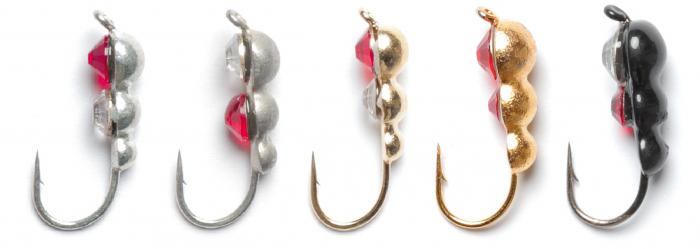
Fishing process
Mixing store-bought bait with a small portion of oatmeal, peas and millet will only increase catchability.
To begin with, the fishing spots need to be fed. Complementary foods must include ingredients containing a lot of sugar, since this commercial fish is recognized as having a real sweet tooth.
Adding store-bought canned corn to the bait mixture in combination with vanillin, cinnamon and fennel brings very good results.
The bait can be purchased at any specialized store and simply mixed with water from a pond or additional components can be added to it, which will give it a special taste and attract much more fish to the fishing spot.
If the basis of the bait is a dung worm, then the bait mixture is increased by adding it (be sure to finely chop it first) to the composition.
Also, it would be a good idea to add some bloodworms, breadcrumbs and milk powder to the mixture. The bait mixture should be offered exclusively in a fresh state, preferably warm, and should have a pleasant, not pronounced aroma.
You can add a couple of tablespoons of cocoa powder while stirring, which will create additional turbidity when diving to the bottom surface and attract the attention of the bream. Particularly successful will be the inclusion of fruit flavors in the composition - pear, banana and raspberry.
The main part of the fishing for bream is carried out at a depth of 3-4 meters , which allows the game to be carried out from the bottom surface to the very surface of the water surface. If a cluster of the largest number of bites is detected, you should fish this particular area, plus the nearby water range, without wasting time and effort on playing throughout the entire territory.
It is worth remembering that a sharp change in weather conditions has a lightning-fast effect on the behavior of fish and in the case when, for example, a strong wind suddenly began to blow or light rain began to fall, the fish may immediately leave the fed area.
At such moments, you should go in search of a school of fish. Effective game methods:
- The method of uniform lifting of equipment is very popular. Be sure to exclude any jerks and vibrations. The animation should start very quickly, gradually reducing the speed in order to monitor the fish’s interest in different frequencies of movements and choose the best option.
- To activate a passive school of fish , it is recommended to slowly lift the equipment and make small vibrations, and lower the jig quickly, without making any jerks.
- Fishermen often increase biting activity with the help of diagonal movements, and when lowering the equipment, leave the jig motionless for 3-5 seconds at the bottom surface.
Fishing in fast-flowing waters means placing the jig near the bottom. Casting is carried out with the current, at the moment when the nod gives a signal that the bait has reached the bottom, you should start casting.
A smooth game must contain small fluctuations. Under no circumstances should the jig reach the bottom surface or rise excessively high. The line must be in a vertical position at all times.
When fishing in reservoirs with a calm or completely absent current, it is recommended to cast as far as possible and as soon as the bait approaches the bottom, you should pull it out in jerks.
The jig rises slightly slowly with short stops; after each stop it should be slightly released.
Vibrations of the tackle can be periodically created by lightly tapping the tackle with your fingers at the place where the reel is attached. If the bottom of the reservoir is covered with vegetation, then you need to find the cleanest possible place for casting. Otherwise, there will be quite a lot of hooks and, accordingly, fish disappearances.
With the onset of severe frosts, commercial fish can only be found at great depths. During this period, to attract the attention of bream, it is recommended to lightly tap the bait directly on the surface of the bottom.
In the warmer months, any type of animation is used. The most important thing is that if there is no bite, you should not despair. It is necessary to offer the fish other types of baits and try a variety of games that will certainly attract the bream.
Fishing technique
The reelless feed can have several options, which may correspond to certain fishing conditions. Each wiring option can be effective and bring bites.
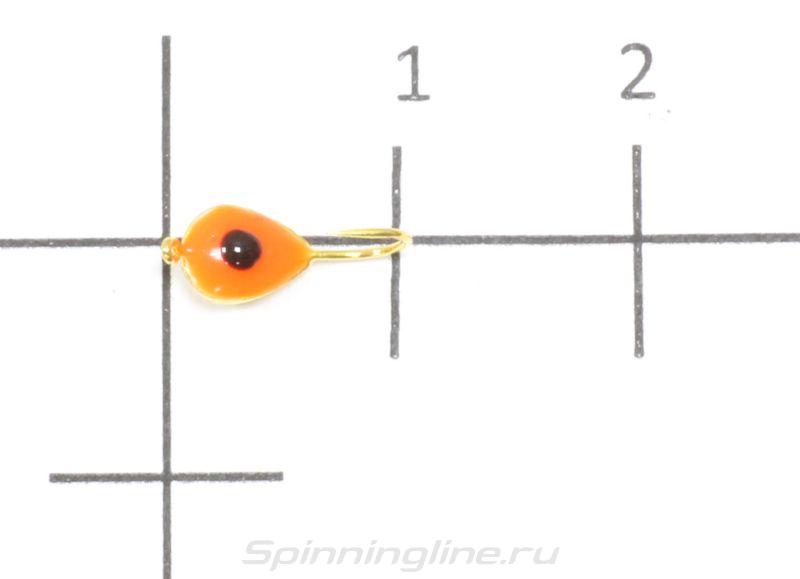
Among the large variety, it is worth highlighting a few of the simplest, but most catchy ones. Classic wiring is used at the initial stage of searching for perch sites.
Anglers call it “shaking” or “dribbling.” It includes frequent oscillations combined with low amplitude.
At the end of the wiring process, it is recommended to pause for about 5 seconds to hold the jig in the upper position.
The second type of wiring is carried out by smoothly lifting the reelless rod while rocking the rod, which has a large amplitude and low frequency. This type of wiring is used when the bite is weak, when the perch behaves passively.
To detect perch, these two types of postings are mainly used.
The action is as follows:
- a hole is drilled;
- The jig is lifted twice, with a pause at the top point after the second lift. The climbs are quite fast;
- Several lifts with rocking are performed.
If after such actions there are no bites, then the wiring should be repeated or, in order not to waste time, go to another hole. It often happens that the perch can be active at first, and then the bite stops.
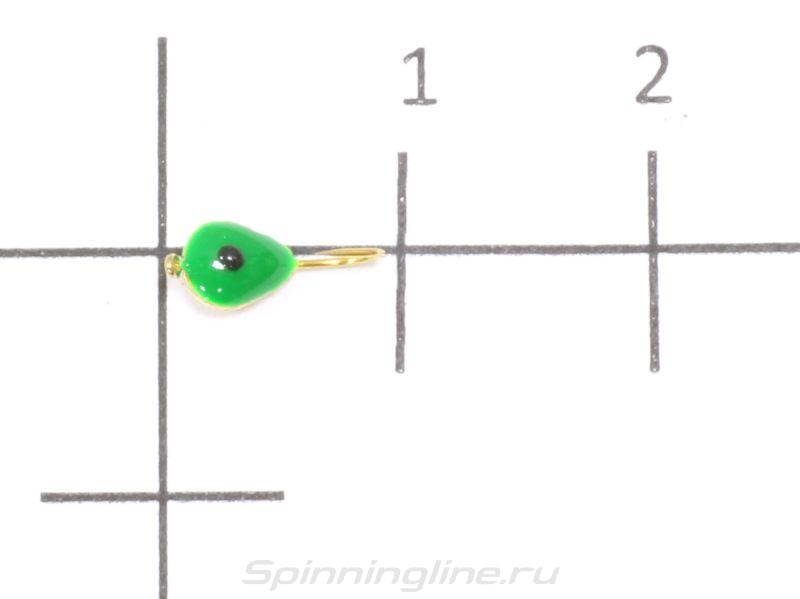
In this case, it makes sense to use other types of postings with active play, alternating with pauses. This is a classic retrieve with quick rises of a few centimeters, after which a stop is made for a few seconds and so on until the jig reaches the highest point.
If there is no result, then you can go the other way around, to slow climbs with pauses. If this does not interest the perch, then you can switch to fast or slow rises, alternating with short (up to 1 second) pauses.
If there is a perch in the area of the drilled hole, then he will definitely be interested in this game. The lack of a bite indicates that you need to move to another place.
Among the wide variety of invented nozzle jigs, the best ones can be noted.
"Ant"
Widely used by anglers when catching perch. For greater efficiency, multi-colored cambrics or beads are hung on it, and sometimes it is effective without them.
You can find “ants” of various sizes. When ice first appears, large baits work well.
The same can be said for the last ice, but throughout the rest of the winter fishing period, small and medium-sized “ants” are more pleasing.
"Uralka"
How to catch bream with a jig in winter
How to choose a catchable place
Fishing for bream in winter
If the reservoir is familiar and fishing is carried out both in summer and in winter, then there will be no problems with choosing a fishing spot. If the body of water is unfamiliar, then everything may be more complicated. As a rule, places are selected where vegetation predominates, with depths of at least 1.5 meters. The water areas next to the pits would be good places. In winter, bream moves little around the reservoir, and holes for it serve as an excellent place where it can hide.
Most anglers choose a tactic where several holes are drilled at once in a checkerboard pattern, although the hole drilling pattern may be different. As a rule, this tactic justifies itself, especially since you need to look for bream and the more holes, the greater the chances of catching fish.
Winter fishing rod and jig mount
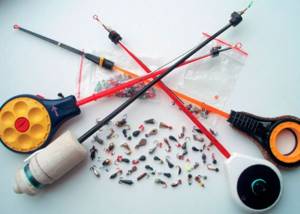
A winter fishing rod for bream should have a long (relatively) rod equipped with a reel with fishing line. Each angler should have several fishing rods with different equipment. This will allow you to quickly determine the preferences of the fish and will not allow you to be left without a catch.
Winter fishing is fraught with many nuances that any fisherman should know about. The jig is attached to the fishing line using a special hole, which is located in the upper part of the bait. To do this, take the fishing line and drag it through this hole, after which several turns are made around the fore-end. Then a loop is formed and tightened. This option for attaching a jig is considered the most reliable if all steps are done correctly. As far as we know, there are quite a lot of ways to attach jigs, so you can use any of them.
Availability of bait
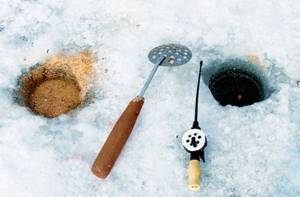
The presence of bait will ensure the capture of fish. Bloodworms are considered the most common bait in winter. Bloodworms are sold in any fishing store and are very inexpensive. Moreover, you should not throw a lot of bloodworms, since the main task is to attract fish, but not to feed them. One handful is enough for each time.
In fishing stores you can buy ready-made loose bait, which can also be used when fishing for bream. Such mixtures contain various flavors that work in cold water, so that the fish quickly senses its aroma and quickly approaches the fishing point. It is also advisable to feed fish in small portions.
Once in the water, it begins to sink, creating a feeding cloud of turbidity. This feeding cloud will immediately interest fish even at a considerable distance. A similar cloud can form if a geyser is added to the bait. You need to know such nuances, especially when preparing bait with your own hands.
Bait options

A good bait for catching bream in winter is the same bloodworm that the fish were fed with. Bloodworms are placed on the hook of a jig, and the more bloodworms, the better. The fish reacts more to a bunch of red bloodworms.
Many anglers use a regular worm, which can easily interest bream in winter. It is better to mount a half worm rather than a whole one, which will attract fish faster due to its aroma.
There are times when the fish behaves very actively and additional baits are not needed; it is enough to offer it a bare jig.
Mormysh is also suitable as bait, but, like a worm, it is difficult to get in winter. It is baited one at a time, but jigs are not considered a priority bait for catching bream.
Do you want to increase your fish catch?
Today there are many ways to increase your catch. One of the interesting options is FishHungry - constant increased feelings of hunger. FishHungry works directly on the instincts of fish at a physiological level, first to attract from a long distance and force them to look for food in the feeding area, and then stimulates the active absorption of this food, even when the fish are full. Although at the moment there is a possibility that these supplements will be banned, they can still be purchased, for example, Here.
Tandem fishing
To quickly fish different horizons of the water column, tandem equipment is used. Structurally, it looks like two jigs located at a distance of 20 to 35 cm from one another. The design makes the bait easier, unloading the weight on two attachments. An eyelet is used as the top one, which is tied in such a way that the hook remains in a horizontal position. The shape of the bottom bait is not important, but the “drop” predominates.
Tandem, like other catchable equipment, has disadvantages, the main one of which is lower quality play. Due to the windage formed by two baits, the frequency of oscillations is lost, and when fishing at a significant depth, it becomes more and more difficult to set it.
How to choose the color of the jig
The color of the bait is one of the main factors influencing the outcome of fishing. But you shouldn’t assume that the brighter the bait, the better the bite. In addition, the wrong color will scare away the fish.
Most anglers believe that a jig should have a multi-color coloring. To do this, they independently modify the bait, painting it with varnish or covering it with copper (silver, aluminum) foil.
It is believed that on a sunny day lures of dark colors (black, gray, gray-green) work better, and in cloudy weather it is better to use light colors (white, golden, silver). However, you shouldn't focus too much on this.
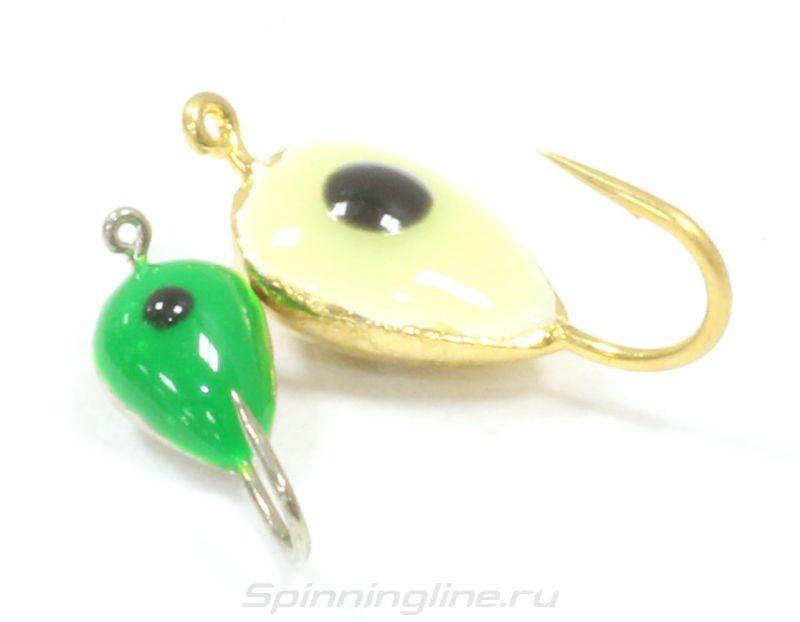
It often happens that one day on one body of water a roach or perch bites on anything, but on another, on the contrary, there is no bite at all, no matter what bait you use. Therefore, it is better to always have different jigs with you: unattached ones of various shapes and colors and regular ones for use with bait.
Fragments of small chains, multi-colored pieces of cambric, beads and sequins can be used as an additional attractive element (replants) for mothless birds. But these trinkets must also have a clearly defined coloring. The following color alternations are usually used for replanting:
- green – orange (yellow) – green;
- white – black – white;
- black – yellow (orange) – black;
- red – white – red;
- gray – red – gray.
For fish species such as perch or roach, during periods of their winter activity, there is nothing more attractive than a nymph jig decorated with bait. Photos of such assembled baits are presented below.
Jigs
The best jig for bream in winter can only be in the opinion of a particular angler for use in certain fishing conditions. Everywhere there are various tops and ratings of the most catchy jigs for bream, but these are tricks of marketers. You need to collect an arsenal of various options, since you don’t know in advance what will “shoot” today. Large bream will even attack a small balancer or spinner. Some fishermen make jigs for bream with their own hands, since they are not satisfied with what the stores offer. Various kinds of drops, ants, lentils, bugs, diamonds, balls - all this can be useful.
The requirements for bait have already been indicated above. Sometimes in winter even specific baits work, which are often used for catching perch. There is often information that ring jig mounts (semi-offset) work better, but there are also a lot of positive reviews when using standard droplets.
Good jigs are those that the angler was able to use competently on a pond, taking into account search, weather, bait, fish behavior and other factors. Therefore, the answer to which jig is better to catch bream in winter is the one that the fisherman was able to skillfully use in these specific conditions of the reservoir and weather.
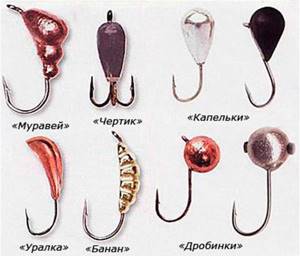
Catchable jigs for crucian carp
Today there are many ways to increase your catch. One of the interesting options is FishHungry - constant increased feelings of hunger.
FishHungry works directly on the instincts of fish at a physiological level, first to attract from a long distance and force them to look for food in the feeding area, and then stimulates the active absorption of this food, even when the fish are full.
Although at the moment there is a possibility that these supplements will be banned, they can still be purchased, for example, Here.
Photos of jigs with your own hands
Read here - DIY winter tent: construction, arrangement, insulation and placement rules. 120 photos of the best models for making your own
Nozzle jigs for roach
This fish, unlike perch, prefers bright colors, regardless of the time of year. For fishing for roach, small reelless baits such as “ant”, “devil”, “moth” are used. For large individuals, there are specialized catchable jigs “tenka” or “jellyfish”.
When catching this fish on the first ice, some anglers practice using several different reelless baits attached to one fishing line. If you have enough experience, you can get a good catch in this way, but for beginners this solution can cause tangling or breakage of the gear.

No matter how wide the range of baits is, amateur fishermen have always made and will continue to make their own. Very often, homemade jigs are made in the image and likeness of factory ones, but taking into account the personal experience of each fisherman, as well as the characteristics of the reservoirs where he fishes.
Tactics for catching and feeding in winter
Tactics and bait for winter bream are inseparable. Proper use of bait for bream is one of the most important conditions for successful fishing. The flock must first be found. To do this, in promising places, holes are drilled at a distance of 20-30 meters (no closer) and fed. The composition of winter bream bait and the rules for its use in winter are described in detail in our article:
https://podlednik.ru/nazhivki-i-podkormki/zimnyaya-prikormka-dlya-leshha
Each hole is then checked, but for this a whole range of winter gear is used, depending on the preferences of the angler and the fishing conditions. In still water, bait is used with a dump truck and a set of fishing rods:
- Winter float.
- Nodding to the boner.
- Mormyshing with a nozzle.
- Mothless.
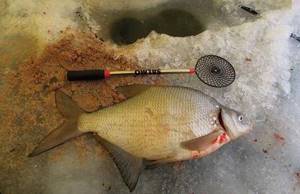
All of these tackles use jigs. During the current, it is better to feed through the second hole, located strictly up from the working hole. It contains a mesh feeder, from which the current washes away the food and forms a feeding spot, respectively, in the direction of the flow.
- Bream fishing is most successful in winter at night; the largest specimens only go to feeding areas at night. Therefore, you need to arrive at the reservoir in advance in order to have time to find a catchable place and stay there for the night.
- Fishing for bream in December using a jig is more active than in the middle of winter.
- At such times, fish can be found in fairly shallow (2-3 meters) places.
- At this time, the rewinder shows itself well.
- Closer to the dead of winter, the bream finally slides into deep holes, and goes out to feed not far from them, on nearby edges, dumps, tables and banks.
It is better to catch it in deep winter exclusively at night (if you need a large bream and not a bream) with bait on a riser from the bottom, periodically checking how it reacts to playing with bait. By the end of winter, the fish become active again, and active methods of searching and fishing in fairly wide water areas come into play again. But these are all matters of personal preference. Some winter fishermen prefer a float, others prefer a nod, and others fish exclusively with no bait. The surest option is versatility, using different gear depending on the conditions and preferences of the fish.
How to catch bream in winter using a jig? Let's consider the main gear and the key points of their installation.

